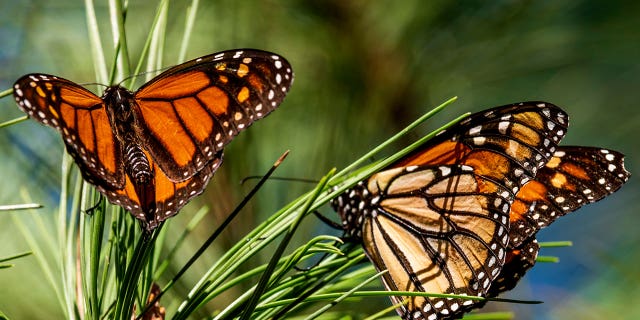Monarch butterflies wintering in California recover for the second year in a row
The population of western monarch butterflies wintering along the coast of California is recovering for the second year in a row after a sharp drop in 2020, but the population of orange-and-black insects is still significantly lower than before, researchers said on Tuesday. .
Volunteers visiting sites in California and Arizona on Thanksgiving counted more than 330,000 butterflies, the largest number of these insects in six years. It was a promising rebound after the annual winter count in 2020 recorded less than 2,000 butterflies. In 2021, 247,000 people were registered.
“I think we can all celebrate and it’s really exciting,” said Emma Pelton, an environmental biologist with the Xerces Society, a non-profit environmental organization dedicated to invertebrate conservation. “We were all so relieved last year when we had about 250,000 butterflies and even a modest increase in that number this year is a really good sign that we have a second chance.”
NATIONAL GEOGRAPHIC SPOTLIGHTS NAMES UNUSUAL PHOTOS AS PHOTO OF THE YEAR: HERE ARE 10 GREAT SHOT
Pelton said it’s unclear why the population has rebounded, but one explanation could be that eastern monarch butterflies, which tend to spend the winter in Mexico, may be intermingling with their western cousins.
“Some of these leaks can happen, and I don’t think we fully understand the system enough to say what it is,” she said. “But I think it’s not that all is well or that we’ve all done human actions that magically made things better.”
The population is still far below what it was in the 1980s, when monarchs numbered in the millions.
Scientists say the number of butterflies in the western states is at a critically low level due to the destruction of their milkweed habitat along their migration path as habitation expands in their territory and the use of pesticides and herbicides increases.

Butterflies perch on branches at Monarch Grove Preserve in Pacific Grove, California on November 10, 2021.
(AP Photo/Nick Kouri, file)
Along with agriculture, climate change is one of the main causes of the monarch’s extinction threat, disrupting the annual migration by 3,000 miles, synchronized with spring and wildflowers.
Every winter, western monarch butterflies head south from the Pacific Northwest to California, returning to the same places and even the same trees where they congregate to keep warm. Monarchs breed over several generations over thousands of miles before reaching California, where they usually arrive in early November. Once warmer weather sets in in March, they spread eastward from California.
On the eastern side of the Rocky Mountains, another population of monarchs travels from southern Canada and the northeastern United States across thousands of miles to spend the winter in central Mexico. Scientists estimate that since the mid-1990s, the population of monarchs in the eastern US has declined by about 80%, but the decline in the western US has been even more dramatic.
NO NORTHERN GIANT HORNETS IN WASHINGTON IN 2022
Adult monarch butterflies live for several weeks, while monarch butterflies, which spend the winter in groups in trees and emerge in late summer and early autumn, can live up to nine months. As temperatures rise, they return to their breeding grounds where their breeding cycle begins anew.
The Western Monarch Count is conducted by trained volunteers over several weeks around the Thanksgiving period. It dates back to 1997 and recorded the loss of over 95% of the population, which, according to earlier studies, once numbered in the few millions.
The insect wintering ground along California’s central coast has also been hit by heavy rainfall this year, with volunteers reporting more monarchs from their flocks and vulnerable to cold, dampness and predators, the Xerces Society said in a statement.
CLICK HERE TO GET THE FOX NEWS APP
The group usually also holds a second count after the New Year. This year’s results will be announced in February and shed light on just how badly winter storms have affected the butterflies, said Isis Howard, an endangered species conservation biologist with the Xerces Society.
Howard said subsequent New Year’s Eve counts typically show a 30% to 50% decrease in butterflies compared to Thanksgiving counts.
“Because this year the storms were so strong and repeated one after another, it seems reasonable to assume that mortality could increase this winter, leading to a decrease in the population that will start the breeding season next spring and summer. ” she said.
Dallas Press News – Latest News:
Dallas Local News || Fort Worth Local News | Texas State News || Crime and Safety News || National news || Business News || Health News
texasstandard.news contributed to this report.









